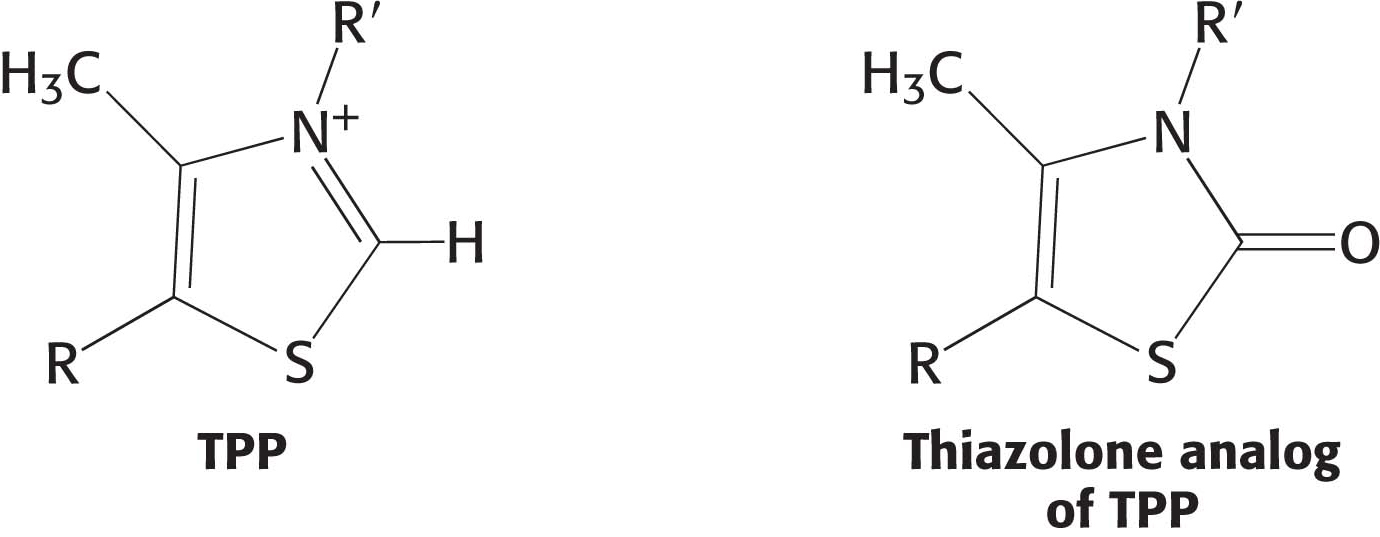PROBLEMS
Question 18.1
1. A one-
Question 18.2
2. Naming names. What are the five enzymes (including regulatory enzymes) that constitute the pyruvate dehydrogenase complex? Which reactions do they catalyze? ✓ 1
Question 18.3
3. Waste and fraud? Figure 18.7 shows the steps in the pyruvate dehydrogenase complex reaction cycle. A key product, acetyl CoA is released after the fourth step. What is the purpose of the remaining steps? ✓ 1
Question 18.4
4. The ol’ two step plus one. The conversion of pyruvate into acetyl CoA consists of three steps. What are these steps? ✓ 1
Question 18.5
5. Predetermined events. The conversion of pyruvate into acetyl CoA commits the carbon atoms to either of two principal fates. What are the fates? ✓ 1
Question 18.6
6. Coenzymes. What coenzymes are required by the pyruvate dehydrogenase complex, and what are their roles?
Question 18.7
7. More coenzymes. Distinguish between catalytic coenzymes and stoichiometric coenzymes in the pyruvate dehydrogenase complex.
Question 18.8
8. Rolling uphill? When lipoamide is reoxidized, what is the immediate electron acceptor and what is the final electron receptor of the reaction? Why is the observed electron transfer unusual?
Question 18.9
9. Like Watson and Holmes. Match each term with its description.
Acetyl CoA Citric acid cycle Pyruvate dehydrogenase complex Thiamine pyrophosphate Lipoic acid Pyruvate dehydrogenase Acetyllipoamide Dihydrolipoyl transacetylase Dihydrolipoyl dehydrogenase Beriberi | Fuel for the citric acid cycle Coenzyme required by transacetylase Central metabolic hub Final product of pyruvate dehydrogenase Catalyzes the link between glycolysis and the citric acid cycle Regenerates active transacetylase Due to a deficiency of thiamine Coenzyme required by pyruvate dehydrogenase Catalyzes the oxidative decarboxylation of pyruvate Catalyzes the formation of acetyl CoA |
Question 18.10
10. Alternative fates. Compare the regulation of the pyruvate dehydrogenase complex in muscle and in liver. ✓ 2
Question 18.11
11. Mutations. (a) Predict the effect of a mutation that enhances the activity of the kinase associated with the PDH complex. (b) Predict the effect of a mutation that reduces the activity of the phosphatase associated with the PDH complex. ✓ 2
Question 18.12
12. Flaking paint, green wallpaper. Claire Boothe Luce, ambassador to Italy in the 1950s (and Connecticut congressperson, playwright, editor of Vanity Fair, and the wife of Henry Luce, founder of Time magazine and Sports Illustrated), became ill when she was staying at the ambassadorial residence in Rome. The arsenic-
Question 18.13
13. Energy rich. What are the thioesters in the reaction catalyzed by PDH complex?
Question 18.14
14. Danbury shakes. From 1850 until World War II, Danbury, Connecticut, was considered the “hat capital of the world.” One popular product was the felted fur hat. In the process of manufacturing the hats, fur was soaked in mercury nitrate. Many of the workers displayed neurological problems, including tremors, which came to be known as the “Danbury shakes.” Suggest a biochemical explanation for the workers’ problems.
Chapter Integration Problems
Question 18.15
15. Alternative fuels. As we will see (Chapter 27), fatty acid breakdown generates a large amount of acetyl CoA. What will be the effect of fatty acid breakdown on pyruvate dehydrogenase complex activity? On glycolysis? ✓ 1
Question 18.16
16. Crucial intermediates. Thioesters not only are important in the reaction catalyzed by the pyruvate dehydrogenase complex, but also are crucial for the generation of pyruvate itself. What is the thioester in glycolysis that helps to generate pyruvate?
Challenge Problems
Question 18.17
17. Lactic acidosis. Patients in shock often suffer from lactic acidosis owing to a deficiency of O2. ✓ 2
(a) Why does a lack of O2 lead to lactic acid accumulation?
(b) One treatment for shock is to administer dichloroacetate (DCA), which inhibits the kinase associated with the pyruvate dehydrogenase complex. What is the biochemical rationale for this treatment?
Question 18.18
18. DCA again. Patients with pyruvate dehydrogenase deficiency show high levels of lactic acid in the blood. However, in some cases, treatment with dichloroacetate (DCA) lowers lactic acid levels.
(a) How does dichloroacetate act to stimulate pyruvate dehydrogenase activity?
(b) What does this suggest about pyruvate dehydrogenase activity in patients who respond to DCA?
Question 18.19
19. Force feeding. Inhibitors of pyruvate dehydrogenase kinase have been proposed as potential treatments for type 2 diabetes, which is characterized by high blood levels of glucose due to insulin resistance. Suggest a biochemical rationale for this proposal. ✓ 2
Question 18.20
20. A potent inhibitor. Thiamine thiazolone pyrophosphate binds to pyruvate dehydrogenase about 20,000 times more strongly than thiamine pyrophosphate does, and it competitively inhibits the enzyme. Why?
Selected Readings for this chapter can be found online at www.whfreeman.com/